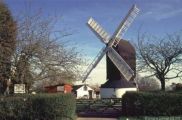
OUTWOOD IN SURREY "The Village with the Mill"
March 2013
Following a mild Christmas and New Year the weather changed by mid January and the wind veered bringing cold weather from northern Europe with icy conditions and a few days of snow, which settled and hung around for over a week before melting away, only to be replaced by more cold weather. In addition there were prolonged periods of wet weather so that during the first six weeks of the year rainfall amounted to 10cms (4 inches) However, despite the freezing conditions, daylight hours are slowly increasing and this is clearly a trigger for the birds. There has been lots of activity in and around the nest box near the bedroom window with a pair of blue tits busily tidying the box and nest building. Meanwhile, nuthatches, which seem to be thriving from the appearance of five of them at the peanut feeder looking like a bunch of schoolchildren at the local sweet shop, have been checking for suitable nest sites. Also, blackbirds and wood pigeons have started their courtship routines and playing their springtime games of chase-me-charlie. After a gap of a couple of months ring necked parakeets have begun making daily feeding visits and the cock pheasant, which has been a regular over the last three years, reappeared in mid February for the first time since the end of October with plumage in top condition.
Common Ivy (Hedera helix) is familiar to all of us, whether choking the hedge bottom, covering old trees or probing its way in under the house eaves. It is best described as a woody evergreen perennial and is one of an ancient group of plants which predate the ice age in Europe during the tertiary period. The plant is unusual in that the leaves are variable, being palmate in shape with five lobes when it is scrambling along the ground or climbing but the leaves on the flowering stems are cordate. The flowering period is October, November and December and the greenish yellow flowers, which are clustered together in a ball shape, are pollinated by bees, wasps and moths and produce their black to orange coloured fruits during December and January. Although poisonous to humans, these fruits provide an invaluable food source for birds such as thrushes, blackcaps, redwings and wood pigeons during the lean winter months. Despite the fact that common ivy climbs by using rootlets that form on the stems it is not generally considered to be a problem when growing on well maintained walls or over large trees where it provides a perfect environment for a wide range of wildlife. Ivy can climb to over thirty metres and there is a veteran example growing into an oak on the side of the footpath between Path End and Burstow Park Farm. The plant must be of considerable age as it is detached from the trunk of the tree for the first five metres and has a gnarled stem - the biggest I've ever seen - that is 38 cms (15 inches) in circumference. An unusual pollinating insect is the Ivy Bee (Colletes hederae), which was new to science in 1993 when it was found in southern Europe. It was first identified in the UK, in Dorset, in 2001 and has now spread across the south of England. This bee, which has an orange coloured thorax and black body striped in pale yellow, nests in loose soil, often in colonies of a few thousand individuals, and they fly during the period early September to mid November coinciding with the flowering of ivy which is their prime food source.
Mike Johnson